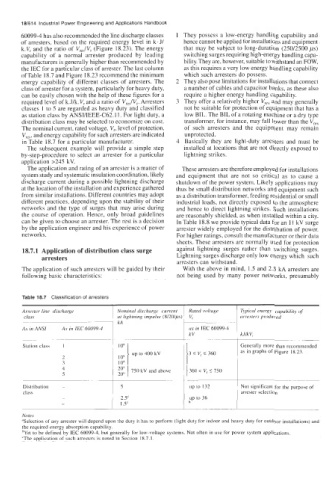Page 649 - Industrial Power Engineering and Applications Handbook
P. 649
18/61 4 Industrial Power Engineering and Applications Handbook
60099-4 has also recommended the line discharge classes 1 They possess a low-energy handling capability and
of arresters, based on the required energy level in k . J/ hence cannot be applied for installations and equipment
k.Vr and the ratio of Vr,,/Vr (Figure 18.23). The energy that may be subject to long-duration (250/2500 ps)
capability of a normal arrester produced by leading switching surges requiring high-energy handling capa-
manufacturers is generally higher than recommended by bility. They are, however, suitable to withstand an FOW,
the IEC for a particular class of arrester. The last column as this requires a very low energy handling capability
of Table 18.7 and Figure 18.23 recommend the minimum which such arresters do possess.
energy capability of different classes of arresters. The 2 They also pose limitations for installations that connect
class of arrester for a system, particularly for heavy duty, a number of cables and capacitor banks, as these also
can be easily chosen with the help of these figures for a require a higher energy handling capability.
required level of k.J/k.V, and a ratio of Vre,/Vr. Arresters 3 They offer a relatively higher VI,, and may generally
classes 1 to 5 are regarded as heavy duty and classified not be suitable for protection of equipment that has a
as station class by ANSI/IEEE-C62.11. For light duty, a low BIL. The BIL of a rotating machine or a dry type
distribution class may be selected to economize on cost. transformer, for instance, may fall lower than the V,,
The nominal current, rated voltage, VI, level of protection. of such arresters and the equipment may remain
V,,,, and energy capability for such arresters are indicated unprotected.
in Table 18.7 for a particular manufacturer. 4 Basically they are light-duty arresters and must be
The subsequent example will provide a simple step installed at locations that are not directly exposed to
by-step-procedure to select an arrester for a particular lightning strikes.
application >245 kV.
The application and rating of an arrester is a matter of These arresters are therefore employed for installations
system study and systematic insulation coordination, likely and equipment that are not so critical as to cause a
discharge current during a possible lightning discharge shutdown of the power system. Likely applications may
at the location of the installation and experience gathered thus be small distribution networks and equipment such
from similar installations. Different countries may adopt as a distribution transformer, feeding residential or small
different practices, depending upon the stability of their industrial loads, not directly exposed to the atmosphere
networks and the type of surges that may arise during and hence to direct lightning strikes. Such installations
the course of operation. Hence, only broad guidelines are reasonably shielded, as when installed within a city.
can be given to choose an arrester. The rest is a decision In Table 18.8 we provide typical data for an 11 kV surge
by the application engineer and his experience of power arrester widely employed for the distribution of power.
networks. For higher ratings, consult the manufacturer or their data
sheets. These arresters are normally used for protection
18.7.1 Application of distribution class surge against lightning surges rather than switching surges.
arresters Lightning surges discharge only low energy which such
arresters can withstand.
The application of such arresters will be guided by their With the above in mind, 1.5 and 2.5 kA arresters are
following basic characteristics: not being used by many power networks, presumably
Table 18.7 Classification of arresters
Arrester line discharge Nnminul discharge current
class ut lighming impul~e (8/20/p
~~
As in ANSI AF in IEC 6i)Ogd kA
1 10" I Generally more than recommended
up to 400 kV 3 I V, I 360 as in graphs of Figure 18.23.
IO"
10"
20" 750 kV and above } 360 < V, 5 750
20"
Distribution 5 up to 132 Not significant for the purpose of
class arrester selection
1 2.5' up to 36
h
1.5'
Notes
"Selection of any arrester will depend upon the duty it has to perform (light duty for indoor and heavy duty for outdoor installations) and
the required energy absorption capability.
bYet to be defined by IEC 60099-4, hut generally for low-voltage systems. Not often in use for power system applications.
'The application of such arresters is noted in Section 18.7.1.

